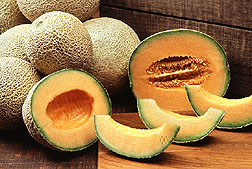Science Update
Global Address for New Technology
About 13,000 summaries of ARS research findings can now be searched in the agency's TEKTRAN database. It's been available on the World Wide Web since April. TEKTRAN is a new online window to ARS research labs—and to farm, food, environmental, and industrial technologies and products of the future. ARS adds new summaries to TEKTRAN after scientists submit manuscripts to scientific journals. Summaries are removed after 3 years. Browsers can conduct a full-text search of the summaries, including titles, keywords, and author information. They can also search by categories such as nutrition, germplasm, pests, and soil management. Some summaries are not posted—to safeguard intellectual property rights of ARS inventors and cooperators. The Internet version of TEKTRAN was developed by the Technology Transfer Information Center (TTIC) of ARS' National Agricultural Library in cooperation with ARS' Office of Technology Transfer (OTT) and National Program Staff. ARS is steadily improving TEKTRAN's scope and convenience. The TTIC home page (http://www.nal.usda.gov/ttic/) offers links for investigating new ARS technologies available for licensing.
Kate Hayes, USDA-ARS, Technology Transfer Information Center, National Agricultural Library, Beltsville, Maryland, phone (301) 504-5218.
Cantaloupe: More Nutritional Clout for a Sweet Favorite
 Cantaloupes, sometimes called muskmelons. (K7388-11) |
Growers and home gardeners have three options for making sweet, succulent cantaloupe a brighter beta carotene star. The fruit's content of this important nutrient is independently influenced by soil texture, fruit size, and melon variety. ARS scientists made this discovery through a 2-year field test. Nutritionists recommend eating plenty of foods rich in beta carotene that the body converts to vitamin A. Beta carotene and lesser known, naturally present substances in foods can boost defenses against cancers and other diseases. Melons—cantaloupe, honeydew, and watermelon—rank second of the 10 most popular fresh fruits. But for supplying beta carotene, cantaloupe is in a league by itself. On average, a cupful provides 160 percent of the Recommended Daily Intake of 5,000 International Units (vitamin A value). That's quadruple the average in the closest competitor, fresh peaches. In the test, researchers measured cantaloupe beta carotene levels as high as 13,295 I.U. Levels were generally higher in cantaloupe grown on silty clay loam than on coarser, sandy loam. Among six size classes, bigger cantaloupe meant higher beta carotene, with one exception. The largest fruits (over 5 pounds) had 25 percent less beta carotene than the second-largest class of 4- to 5-pounders. Differences among commercial varieties were less pronounced, but Mission and Cristobal had the highest beta carotene levels of six varieties tested.
Gene Lester, USDA-ARS Crop Quality and Fruit Insects Research Unit, Weslaco, Texas, phone (956) 447-6322.
Sensing New Agricultural Tools Ahead
Instruments for espionage and war might be refashioned into hi-tech agricultural eyes, ears, and noses. This is the intent of ARS and Advanced Information Management and Movement, Inc., of Starkville, Mississippi. Scientists will examine, for example, whether computer systems that detect dangerous chemicals on the battlefield can be adapted to sense insect pheromones. The pheromones may signal an impending attack on crops by six-legged invaders. There are several other potential applications of the scientists' effort, conducted under a cooperative research and development agreement. A few examples: radar used to measure cotton growth, devices to alert growers to snoop on pesky insects' conversations (rustling crop leaves as they feed), and modified weather-charting systems to detect plant stress and soil moisture.
Jim McKinion, USDA-ARS Genetics and Precision Agriculture Research Unit, Mississippi State, Mississippi, phone (662) 320-7449.
"Science Update" was published in the October 1996 issue of Agricultural Research magazine.






